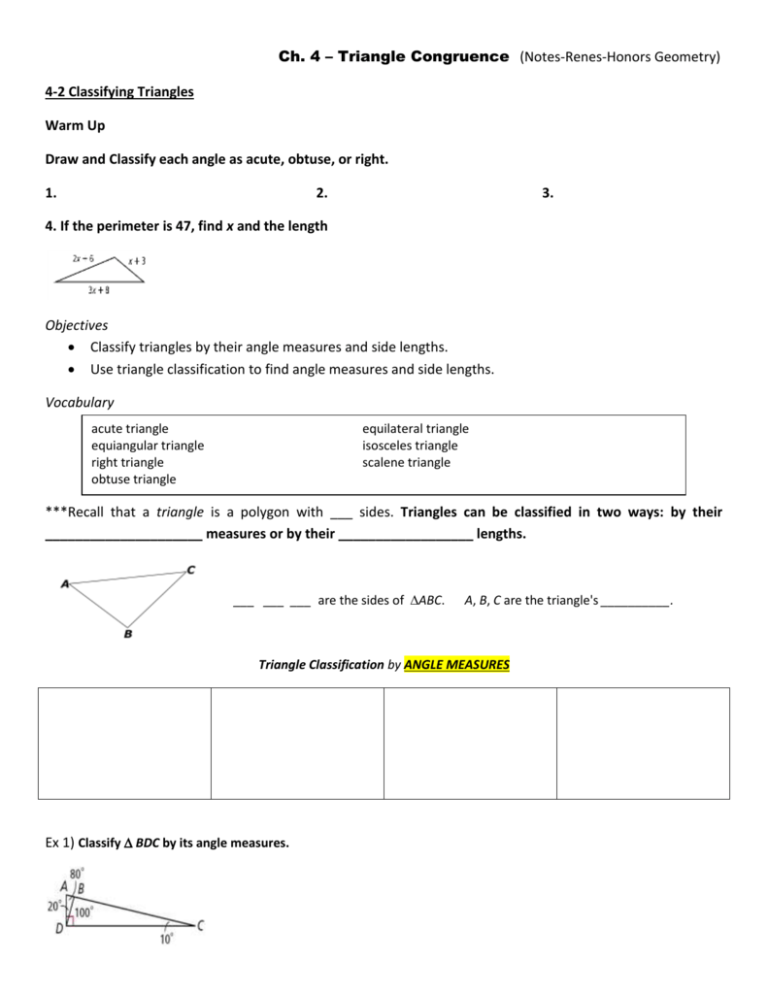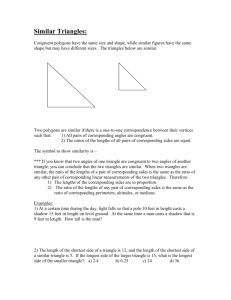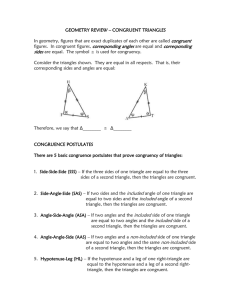An auxiliary line used in the Triangle Sum Theorem
advertisement

Ch. 4 – Triangle Congruence (Notes-Renes-Honors Geometry) 4-2 Classifying Triangles Warm Up Draw and Classify each angle as acute, obtuse, or right. 1. 2. 3. 4. If the perimeter is 47, find x and the length Objectives Classify triangles by their angle measures and side lengths. Use triangle classification to find angle measures and side lengths. Vocabulary acute triangle equiangular triangle right triangle obtuse triangle equilateral triangle isosceles triangle scalene triangle ***Recall that a triangle is a polygon with ___ sides. Triangles can be classified in two ways: by their _____________________ measures or by their __________________ lengths. ___ ___ ___ are the sides of ABC. A, B, C are the triangle's __________. Triangle Classification by ANGLE MEASURES Ex 1) Classify BDC by its angle measures. Classify ABD by its angle measures. Classify FHG by its angle measures. Triangle Classification by SIDE LENGTHS ***Remember***When you look at a figure, you cannot assume segments are congruent based on appearance. They must be marked as congruent. Ex 2) Classify EHF by its side lengths Classify EHG by its side lengths. Classify ACD by its side lengths. Example 3: Using Triangle Classification Find the side lengths of JKL. Find the side lengths of equilateral FGH. Example 4: Application A steel mill produces roof supports by welding pieces of steel beams into equilateral triangles. Each side of the triangle is 18 feet long. How many triangles can be formed from 420 feet of steel beam? Each measure is the side length of an equilateral triangle. Determine how many 10 in. triangles can be formed from a 100 in. piece of steel. 4-3 Angle Relationships in Triangles Warmup 1. Find the measure of exterior DBA of BCD, if mDBC = 30°, mC= 70°, and mD = 80°. 2. What is the complement of an angle with measure 17°? 3. How many lines can be drawn through N parallel to MP? Why? Objectives Find the measures of interior and exterior angles of triangles. Apply theorems about the interior and exterior angles of triangles. Vocabulary auxiliary line corollary interior exterior interior angle exterior angle remote interior angle An auxiliary line is a line that is added to a figure to aid in a proof. Example 1A: Application After an accident, the positions of cars are measured by law enforcement to investigate the collision. Use the diagram drawn from the information collected to find mXYZ. Use the diagram to find mMJK. A corollary is a theorem whose proof follows directly from another theorem. Here are two corollaries to the Triangle Sum Theorem. Example 2: Finding Angle Measures in Right Triangles One of the acute angles in a right triangle measures 2x°. What is the measure of the other acute angle? The measure of one of the acute angles in a right triangle is 63.7°. What is the measure of the other acute angle? The measure of one of the acute angles in a right triangle is x°. What is the measure of the other acute angle? 2 The measure of one of the acute angles in a right triangle is 485. What is the measure of the other acute angle? The interior is the set of all points inside the figure. The exterior is the set of all points outside the figure. An interior angle is formed by two sides of a triangle. An exterior angle is formed by one side of the triangle and extension of an adjacent side. Each exterior angle has two remote interior angles. A remote interior angle is an interior angle that is not adjacent to the exterior angle. Example 3: Applying the Exterior Angle Theorem Find mB Find mACD Example 4: Applying the Third Angles Theorem Find mK and mJ Find mP and mT Warm Up 1. Name all sides and angles of ∆FGH. 2. What is true about K and L? Why? 3. What does it mean for two segments to be congruent? 4-4 Congruent Triangles Objectives Use properties of congruent triangles. Prove triangles congruent by using the definition of congruence. Vocabulary corresponding angles corresponding sides congruent polygons Geometric figures are congruent if they are the same size and shape. Corresponding angles and corresponding sides are in the same position in polygons with an equal number of sides. Two polygons are congruent polygons if and only if their corresponding sides are congruent. Thus triangles that are the same size and shape are congruent. Two vertices that are the endpoints of a side are called _____________________ For example ,_____ and _____ are consecutive vertices. ___________________ To name a polygon, write the vertices in consecutive order. For example, you can name polygon PQRS as QRSP or SRQP, but not as PRQS. In a congruence statement, the order of the vertices indicates the corresponding parts. ***When you write a statement such as ABC DEF, you are also stating which parts are congruent.*** Example 1: Naming Congruent Corresponding Parts -Given: ∆PQR ∆STW Identify all pairs of corresponding congruent parts. Angles: Sides: -If polygon LMNP polygon EFGH, identify all pairs of corresponding congruent parts. Example 2A: Using Corresponding Parts of Congruent Triangles Given: ∆ABC ∆DBC. Find the value of x. Find mDBC. Given: ∆ABC ∆DEF Find the value of x. Find mF Example 3: Proving Triangles Congruent Given: YWX and YWZ are right angles. YW bisects XYZ. W is the midpoint of XZ. XY YZ. Prove: ∆XYW ∆ZYW Given: AD bisects BE. BE bisects AD. AB DE, A D Prove: ∆ABC ∆DEC Proof Statements Reasons______ Proof Statements Reasons______ Example 4: Engineering Application The diagonal bars across a gate give it support. Since the angle measures and the lengths of the corresponding sides are the same, the triangles are congruent. Given: PR and QT bisect each other. PQS RTS, QP RT Prove: ∆QPS ∆TRS Proof Statements Reasons____________ Given: MK bisects JL. JL bisects MK. JK ML. JK || ML. Prove: ∆JKN ∆LMN Statements Proof Reasons____________ 4-5 Triangle Congrunece: SSS and SAS Warm Up 1. Name the angle formed by ray AB and ray AC. 2. Name the three sides of ABC. 3. ∆QRS ∆LMN. Name all pairs of congruent corresponding parts. Objectives Apply SSS and SAS to construct triangles and solve problems. Prove triangles congruent by using SSS and SAS. Vocabulary - triangle rigidity - included angle In Lesson 4-3, you proved triangles congruent by showing that all six pairs of corresponding parts were congruent. The property of triangle rigidity gives you a shortcut for proving two triangles congruent. It states that if the side lengths of a triangle are given, the triangle can have only one shape. Adjacent triangles share a side, so you can apply the Reflexive Property to get a pair of congruent parts. Draw: Example 1: Using SSS to Prove Triangle Congruence Use SSS to explain why ∆ABC ∆DBC. Use SSS to explain why ∆ABC ∆CDA. An included angle is an angle formed by two adjacent sides of a polygon. B is the included angle between sides AB and BC. The letters SAS are written in that order because the congruent angles must be between pairs of congruent corresponding sides!!! Example 2: Engineering Application The diagram shows part of the support structure for a tower. Use SAS to explain why ∆XYZ ∆VWZ. Use SAS to explain why ∆ABC ∆DBC. The SAS Postulate guarantees that if you are given the lengths of two sides and the measure of the included angles, you can construct one and only one triangle. Example 3: Verifying Triangle Congruence Show that the triangles are congruent for the given value of the variable. ∆MNO ∆PQR, when x = 5. ∆STU ∆VWX, when y = 4. Show that ∆ADB ∆CDB, t = 4. Given: BC ║ AD, BC AD Prove: ∆ABD ∆CDB Given: ray QP bisects RQS. QR QS Prove: ∆RQP ∆SQP Proof Statements Reasons____________ Proof Statements Reasons__________________ Warm Up 1. What are sides AC and BC called? Side AB? 2. Which side is in between A and C? 3. Given DEF and GHI, if D G and E H, why is F I? 4-6 Triangle Congrunece: ASA , AAS, and HL Objectives - Apply ASA, AAS, and HL to construct triangles and to solve problems. - Prove triangles congruent by using ASA, AAS, and HL. Vocabulary - Included Side An included side is the common side of two consecutive angles in a polygon. The following postulate uses the idea of an included side. Participants in an orienteering race use a map and a compass to find their way to checkpoints along an unfamiliar course. Directions are given by bearings, which are based on compass headings. For example, to travel along the bearing S 43° E, you face south and then turn 43° to the east. Example 1: Problem Solving Application A mailman has to collect mail from mailboxes at A and B and drop it off at the post office at C. Does the table give enough information to determine the location of the mailboxes and the post office? Example 2: Applying ASA Congruence Determine if you can use ASA to prove the triangles congruent. Explain. Determine if you can use ASA to prove NKL LMN. Explain. You can use the Third Angles Theorem to prove another congruence relationship based on ASA. This theorem is Angle-Angle-Side (AAS). Example 3: Using AAS to Prove Triangles Congruent Use AAS to prove the triangles congruent. Given: X V, YZW YWZ, XY VY Prove: XYZ VYW Given: JL bisects KLM, K M Prove: JKL JML Example 4A: Applying HL Congruence Determine if you can use the HL Congruence Theorem to prove the triangles congruent. If not, tell what else you need to know. Determine if you can use the HL Congruence Theorem to prove ABC DCB. If not, tell what else you need to know.






